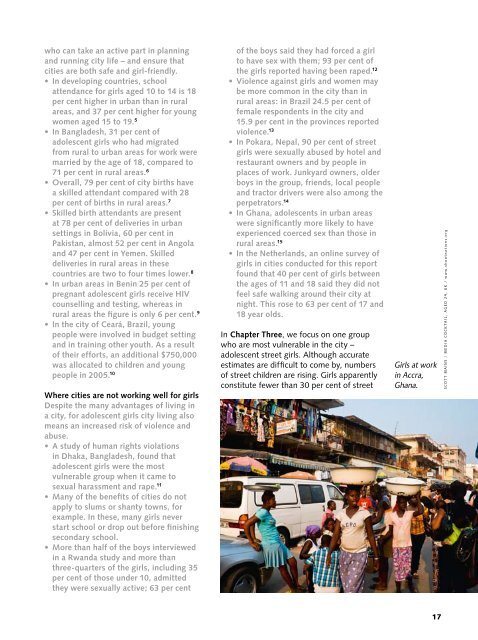Because I am a Girl: Urban and Digital Frontiers - Plan International
Because I am a Girl: Urban and Digital Frontiers - Plan International
Because I am a Girl: Urban and Digital Frontiers - Plan International
Create successful ePaper yourself
Turn your PDF publications into a flip-book with our unique Google optimized e-Paper software.
who can take an active part in planning<br />
<strong>and</strong> running city life – <strong>and</strong> ensure that<br />
cities are both safe <strong>and</strong> girl-friendly.<br />
• In developing countries, school<br />
attendance for girls aged 10 to 14 is 18<br />
per cent higher in urban than in rural<br />
areas, <strong>and</strong> 37 per cent higher for young<br />
women aged 15 to 19. 5<br />
• In Bangladesh, 31 per cent of<br />
adolescent girls who had migrated<br />
from rural to urban areas for work were<br />
married by the age of 18, compared to<br />
71 per cent in rural areas. 6<br />
• Overall, 79 per cent of city births have<br />
a skilled attendant compared with 28<br />
per cent of births in rural areas. 7<br />
• Skilled birth attendants are present<br />
at 78 per cent of deliveries in urban<br />
settings in Bolivia, 60 per cent in<br />
Pakistan, almost 52 per cent in Angola<br />
<strong>and</strong> 47 per cent in Yemen. Skilled<br />
deliveries in rural areas in these<br />
countries are two to four times lower. 8<br />
• In urban areas in Benin 25 per cent of<br />
pregnant adolescent girls receive HIV<br />
counselling <strong>and</strong> testing, whereas in<br />
rural areas the figure is only 6 per cent. 9<br />
• In the city of Ceará, Brazil, young<br />
people were involved in budget setting<br />
<strong>and</strong> in training other youth. As a result<br />
of their efforts, an additional $750,000<br />
was allocated to children <strong>and</strong> young<br />
people in 2005. 10<br />
Where cities are not working well for girls<br />
Despite the many advantages of living in<br />
a city, for adolescent girls city living also<br />
means an increased risk of violence <strong>and</strong><br />
abuse.<br />
• A study of human rights violations<br />
in Dhaka, Bangladesh, found that<br />
adolescent girls were the most<br />
vulnerable group when it c<strong>am</strong>e to<br />
sexual harassment <strong>and</strong> rape. 11<br />
• Many of the benefits of cities do not<br />
apply to slums or shanty towns, for<br />
ex<strong>am</strong>ple. In these, many girls never<br />
start school or drop out before finishing<br />
secondary school.<br />
• More than half of the boys interviewed<br />
in a Rw<strong>and</strong>a study <strong>and</strong> more than<br />
three-quarters of the girls, including 35<br />
per cent of those under 10, admitted<br />
they were sexually active; 63 per cent<br />
of the boys said they had forced a girl<br />
to have sex with them; 93 per cent of<br />
the girls reported having been raped. 12<br />
• Violence against girls <strong>and</strong> women may<br />
be more common in the city than in<br />
rural areas: in Brazil 24.5 per cent of<br />
female respondents in the city <strong>and</strong><br />
15.9 per cent in the provinces reported<br />
violence. 13<br />
• In Pokara, Nepal, 90 per cent of street<br />
girls were sexually abused by hotel <strong>and</strong><br />
restaurant owners <strong>and</strong> by people in<br />
places of work. Junkyard owners, older<br />
boys in the group, friends, local people<br />
<strong>and</strong> tractor drivers were also <strong>am</strong>ong the<br />
perpetrators. 14<br />
• In Ghana, adolescents in urban areas<br />
were significantly more likely to have<br />
experienced coerced sex than those in<br />
rural areas. 15<br />
• In the Netherl<strong>and</strong>s, an online survey of<br />
girls in cities conducted for this report<br />
found that 40 per cent of girls between<br />
the ages of 11 <strong>and</strong> 18 said they did not<br />
feel safe walking around their city at<br />
night. This rose to 63 per cent of 17 <strong>and</strong><br />
18 year olds.<br />
In Chapter Three, we focus on one group<br />
who are most vulnerable in the city –<br />
adolescent street girls. Although accurate<br />
estimates are difficult to come by, numbers<br />
of street children are rising. <strong>Girl</strong>s apparently<br />
constitute fewer than 30 per cent of street<br />
<strong>Girl</strong>s at work<br />
in Accra,<br />
Ghana.<br />
Scott Mains / Media Cocktail, AGED 24, UK / www.shootnations.org<br />
17

















